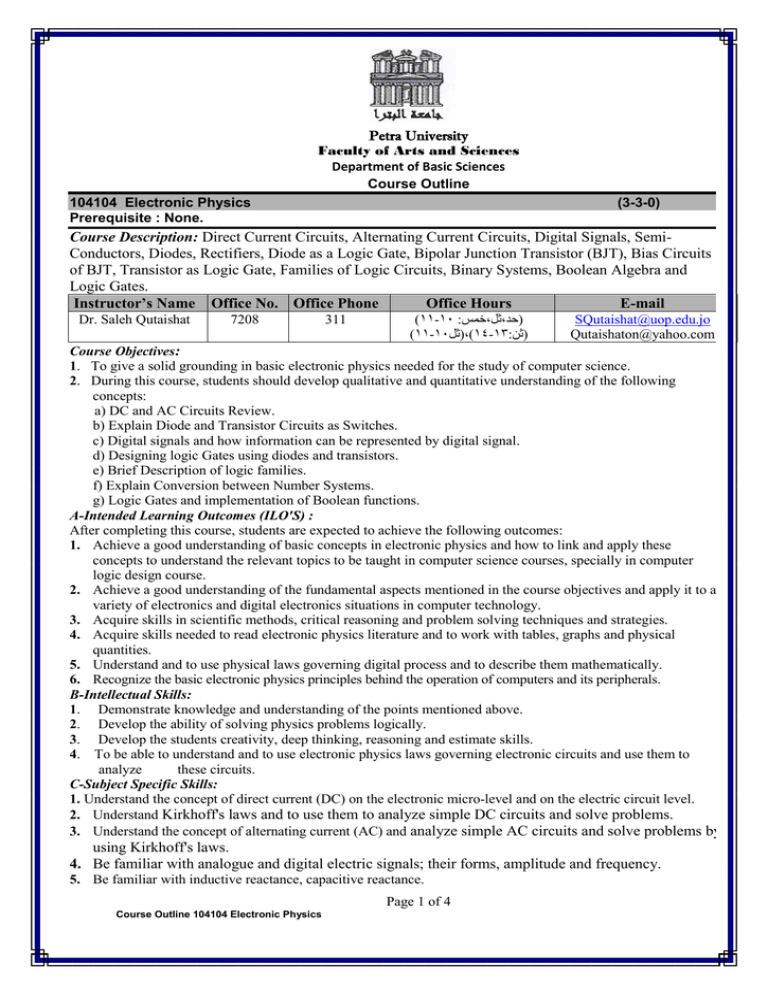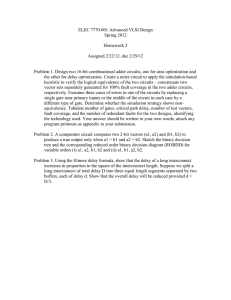Course Description: Direct Current Circuits, Alternating Current
advertisement

Petra University Faculty of Arts and Sciences Department of Basic Sciences Course Outline 104104 Electronic Physics Prerequisite : None. (3-3-0) Course Description: Direct Current Circuits, Alternating Current Circuits, Digital Signals, SemiConductors, Diodes, Rectifiers, Diode as a Logic Gate, Bipolar Junction Transistor (BJT), Bias Circuits of BJT, Transistor as Logic Gate, Families of Logic Circuits, Binary Systems, Boolean Algebra and Logic Gates. Instructor’s Name Office No. Office Phone Office Hours E-mail Dr. Saleh Qutaishat 7208 311 )00-01 :خمس،ثل،)حد )00-01(ثل،)04-03:)ثن SQutaishat@uop.edu.jo Qutaishaton@yahoo.com Course Objectives: 1. To give a solid grounding in basic electronic physics needed for the study of computer science. 2. During this course, students should develop qualitative and quantitative understanding of the following concepts: a) DC and AC Circuits Review. b) Explain Diode and Transistor Circuits as Switches. c) Digital signals and how information can be represented by digital signal. d) Designing logic Gates using diodes and transistors. e) Brief Description of logic families. f) Explain Conversion between Number Systems. g) Logic Gates and implementation of Boolean functions. A-Intended Learning Outcomes (ILO'S) : After completing this course, students are expected to achieve the following outcomes: 1. Achieve a good understanding of basic concepts in electronic physics and how to link and apply these concepts to understand the relevant topics to be taught in computer science courses, specially in computer logic design course. 2. Achieve a good understanding of the fundamental aspects mentioned in the course objectives and apply it to a variety of electronics and digital electronics situations in computer technology. 3. Acquire skills in scientific methods, critical reasoning and problem solving techniques and strategies. 4. Acquire skills needed to read electronic physics literature and to work with tables, graphs and physical quantities. 5. Understand and to use physical laws governing digital process and to describe them mathematically. 6. Recognize the basic electronic physics principles behind the operation of computers and its peripherals. B-Intellectual Skills: 1. Demonstrate knowledge and understanding of the points mentioned above. 2. Develop the ability of solving physics problems logically. 3. Develop the students creativity, deep thinking, reasoning and estimate skills. 4. To be able to understand and to use electronic physics laws governing electronic circuits and use them to analyze these circuits. C-Subject Specific Skills: 1. Understand the concept of direct current (DC) on the electronic micro-level and on the electric circuit level. 2. Understand Kirkhoff's laws and to use them to analyze simple DC circuits and solve problems. 3. Understand the concept of alternating current (AC) and analyze simple AC circuits and solve problems by using Kirkhoff's laws. 4. Be familiar with analogue and digital electric signals; their forms, amplitude and frequency. 5. Be familiar with inductive reactance, capacitive reactance. Page 1 of 4 Course Outline 104104 Electronic Physics 6. Be able to analyze RLC resonance circuit and calculate its impedance and its resonance frequency. 7. Get an idea about the construction of a diode from n type and p type semi-conducting materials, its characteristics and its use as a logic gate. 8. Be able to use the diode in OR gate and AND gate digital electronic circuits. 9. Understand the construction, operation and characteristic curves of bipolar junction transistor (BJT). 10. Be able to bias the transistor using different types of biasing methods. 11. Use the transistor in amplifier circuits and use it in NOT, AND, NAND, OR and NOR transistor logic gates. 12. Know and use binary, decimal, octal and hexadecimal number systems. 13. Represent binary numbers by electric pulses. 14. Know and use digital codes; BCD, Gray, X-3, ASCII. 15. Understand and use Boolean algebra, De Morgan's theorem and logic gates. 16. Understand and use, AND, NAND, OR,NOR, XOR and X-NOR digital logic gates. 17. Know and distinguish DTL, TTL and ECL basic logic families. D-Transferable Skills: 1. Develop cooperative work habits and communication skills. 2. Develop a sense of responsibility. 3. Understand how the scientific method can be used to increase our knowledge in computer technology. Teaching Methods: Method Contact Hours Lectures And Discussions 42 50-minute lectures Learning Outcomes Achieved By Each Teaching Method: Metod Lectures & Discussions Syllabus: Achieved outcome All outcomes Week Lecture Ref. Category Direct Current Circuits (Serway) 1 1 28.1 DC Current 1 2 28.2 1 3 28.3 Alternating Current (Serway) 2 1 33.1 AC Current 2 33.2 33.3 33.4 2 3 33.5 33.7 Digital signals (Floyed) 3 1 1.2 3 2 2 Digital Signals 1.2 3 3 1.2 Semi-conductors (Nashalsky) 4 1 1.3 Semi-conductors 1.5 Topics Power source Resistance combination. Kirchhoff's Rules and circuit analysis. AC potential standard equation, The AC current standard equation. Definition of different parameters; frequency; period time, angular frequency. The relationship between these parameters. RMS value. Resistance in AC circuit. Inductance in AC circuit. Capacitance in AC circuit. The RLC circuit. Resonance. Definition, Electric pulse, Pulse parameters; High level, Low level, Amplitude, Pulse width. Repetition time. Positive and Negative pulse. Uniform digital signal, Clock signal, Non-uniform signal and Data representation. Signals timing diagram. Serial and parallel transfer Semi-conductors. Extrinsic Materials-n-type and p-type. Page 2 of 4 Course Outline 104104 Electronic Physics Assessed by Exams




